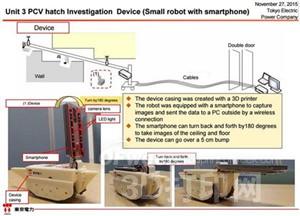Recently, Tokyo Electric Power Company (TEPCO) dispatched a robot with a smart phone to the No. 3 reactor of the Fukushima Daiichi nuclear power plant, which was destroyed during the 2011 Fukushima nuclear disaster. The robot is surrounded by a 3D printed casing, and the Tokyo Electric Power Company system can use it to obtain images and data inside the reactor, so that it is hoped to understand the state of the main vessel (PCV) hatch of Unit 3. These places cannot be surveyed by manpower due to strong nuclear radiation.

In March 2011, a magnitude 9 earthquake occurred in the eastern seas of Japan, causing a tsunami, resulting in a serious nuclear accident at the Fukushima Daiichi nuclear power plant under the Tokyo Electric Power Company. The accident was considered to have been since 1986 in Cherkbelli, Ukraine. The most serious nuclear disaster since the nuclear leak. Now that four years have passed, the consequences of this disaster have not been eliminated, and the clean-up work for the Fukushima nuclear power plant is still far away.
At present, Tokyo Electric Power Company is investigating the status of the main vessel (PCV) hatch of Unit 3 to determine the extent of its damage, and is developing procedures and methods to remove nuclear fuel debris.
In fact, on September 9 this year, the company has already sent a portable camera to the hatch. Now the company has sent a remote control robot with a larger range of activities, and connected a smart phone to collect more More data and images. The device's housing is created with a 3D printer and is equipped with an LED light that allows the device to transmit information to the remote computer in an infinite way. In order to make it easy to take pictures, this smartphone can be flipped back and forth 180 degrees. In addition, the shape of the robot is also very similar to the tank, it can cross the obstacle of 5 cm high.
Tokyo Electric Power Company announced that their robots have received valuable information so that they can see that there are no stains on the upper periphery of the hatch cover, but sewage, dirt and rust are found inside. In the first survey conducted in September, the company also found that there was no cooling water leaking from the inside of the hatch and it was not damaged. However, the floor is wet and they cannot confirm where the water comes from. In addition, the video shows white noise caused by extremely high levels of radiation.
However, it is still too early to draw conclusions about the current status of the No. 3 reactor and even the entire Fukushima Daiichi nuclear power plant. This is only the first time that the company uses remotely controlled 3D printing robots to collect information from the Fukushima nuclear power plant. Steps, and this practice may be further refined and expanded to help staff understand the current internal situation of the nuclear power plant.
Below is a video of this 3D printing robot surveyed at the hatch of Unit 3:
Library Style Bookcase,Large Library Bookcase,Mobile Storage System
LUOYANG SHIDIU IMPORT AND EXPORT CO., LTD , https://www.shidiucabinet.com
